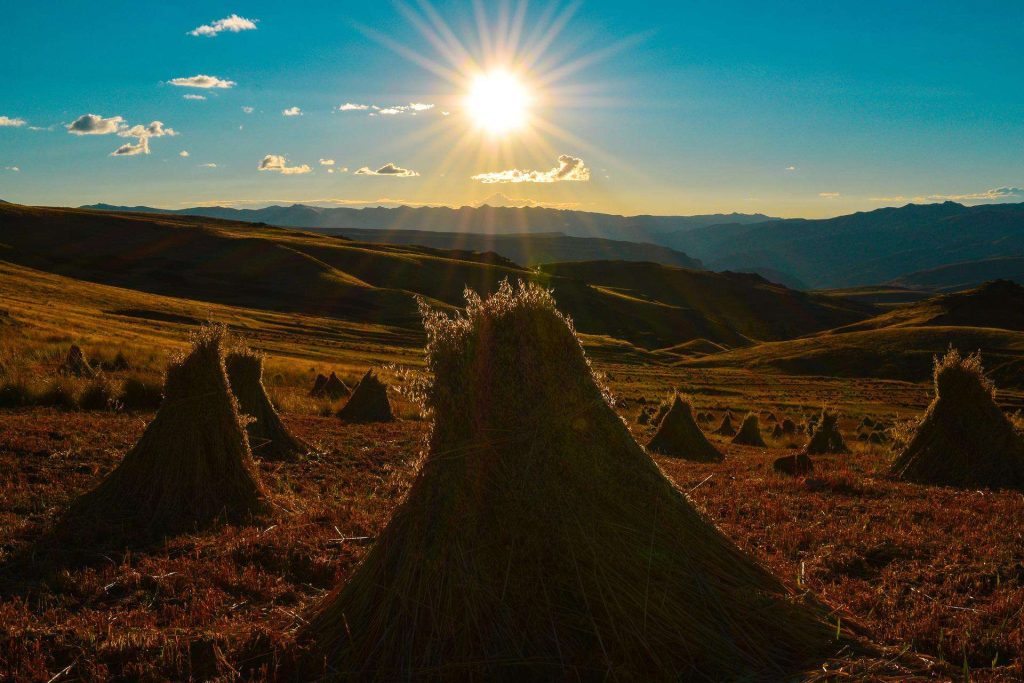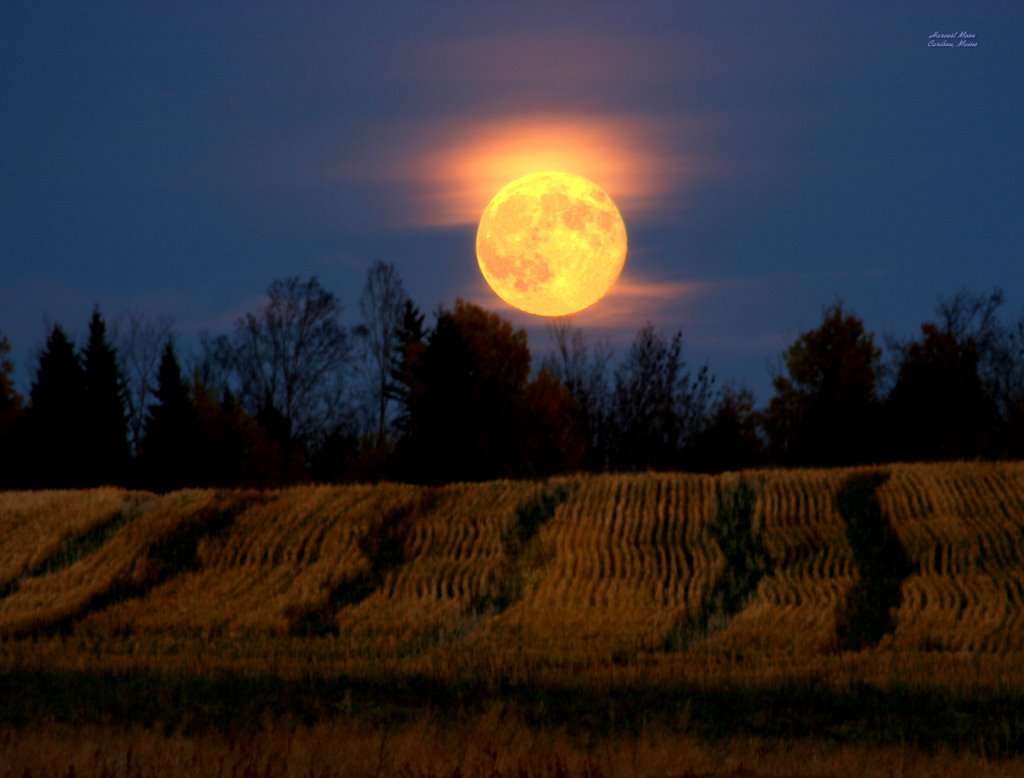Autumn Equinox is also called: Alban Elfed (Welsh), Mabon or Harvest.
Occurs between 21st – 23rd September in the Northern Hemisphere. If you are in the Southern Hemisphere you need to reverse this information.

What is the Autumn Equinox?
The Autumn Equinox is the time of equal light and dark. It is on this date that the Sun crosses the equator on its journey back into the southern hemisphere. Whilst the Sun is crossing the equator all parts of the world get roughly the same length of day and night. Afterwards the southern hemisphere goes into its summer-time with the days getting longer. The northern hemisphere goes into its winter with shorter days.
From this day onward the Sun no longer outshines the darkness. It is a gateway – the stepping stone between the light half of the year and the dark half. The nights draw in & the air gets a distinct ‘nip’ to it – a sure sign of the winter months ahead.
This is also the time of the Harvest, a time of feasting, a time of celebration – the crops are all safely gathered in and it is a time of plenty.
The Moon at Autumn Equinox
Full moon names usually reflect the time of year they happen. This is true for the full moon closest to the Autumn Equinox which is called the Harvest moon. On average the Moon rises 50 minutes later each day. The full moon rises just as the Sun sets. In the northern hemisphere around the Harvest Moon, however, the difference in the time of moonrise from one day to the next is much shorter than this; around 10-15 minutes in the UK. With successive moonrises coming around the same time of day, it feels like there are several Full Moons in a row.
Historically, a full moon occuring just after sunset at harvest time meant that farmers could carry on working into the evening. When this extra moonlight occured for several days in a row it really did feel like nature was giving the harvest a helping hand. This is what makes a harvest moon so special.

Autumn Equinox Energies
The energies that surround the Autumn Equinox are focused around the transition into the winter season. This is something that everything and everyone must respond to; including the Earth herself.
From the Autumn Equinox things begin to move quickly. Change is in progress. In nature the leaves are changing colour and beginning to drop from the trees. The sap in trees and plants has stopped rising and is beginning to move back down into the roots. The fruits, nuts & berries are ripening quickly and will need gathering in.
This withdrawing back down into the Earth signals that the time is fast approaching to go within and focus on our inner-world, but first we must make sure that all jobs are completed. That our harvests are all gathered in and safely stored for the winter. We are not just talking in the ‘literal & physical’ sense but also in the psychological and metaphysical senses.
The cycle of change, which is endless throughout the year, constantly brings the opportunity to explore and understand ourselves. Our harvest time is an excellent point at which to start this work. We can look back and give thanks for everything that we have received/achieved since Spring when the growth started. At each of the celebrations we can welcome this turning energy.
Balance
This is the time to prepare to journey back into our inner, spiritual selves and seek to bring the balance back between our inner and outer worlds. This is the time to balance and reconcile opposites because we need both sides to be whole. Materialism and spirituality, the seen and unseen, known and unknown, death and rebirth are all essential to balancing our inner as well as our outer journey. We can find the source of our inner world.
The ‘dark half’ of the year is not only a time for nature to hibernate, it is also a time for us to invest in long term planning and incubation. The trees and plants spend this time developing the new growth and shoots that will emerge in the spring as next years vegetation. So too will the ideas that we plant now be transformed by their time in our unconscious inner world, to emerge evolved, strengthened and ready for developement. Now is the time to dream a new dream.
Dragons and the Autumn Equinox (Alban Elfed)
In old England, Wales, and other cultures around the world, the two equinoxes of the year were known as Dragon Days, and these wonderful creatures were celebrated in fairs, processions and in general merriment. Dragons, (or representations of them) were carried through the streets. They carry the Fire energy into the inner realms, to activate the fire within at the Autumn Equinox.
It is said that the dragon goes underground for the winter at the Autumn Equinox, and then surfaces again at the Spring Equinox. The dragon is an ancient energy symbol representing Earth energy, dynamism, fire, will and courage! This is the energy that we take with us as we journey into our inner, dark, spiritual realms.
Autumn Equinox Folk-Lore Customs and Traditions
The core beliefs of our rural communities has remained little changed. Probably since our hunter-fisher-gatherer days and certainly once we started farming. Our traditional rural communities still tend to be animistic; believing that all living things have a spirit and that that spirit must be ‘revered’.
So there are correct procedures to follow; correct language to use; rituals that must be observed to prevent ill from falling upon you. This is how you ensure that good fortune comes your way. It is also how you protect yourself and your household over the coming dark winter months. It is no wonder that we have some wonderful (and sometimes weird) customs and practices that surround harvest time.
The Last Sheaf
When crops of grains (Wheat, Barley, Oats) were harvested by hand (hand-held sickle or scythe), groups of labourers would work systematically around the field. Working from the outside edges, toward the centre, they cut the crop and tied it into sheaves (small bundles) which in turn would be stood in ‘stooks’ (bundles of sheaves stood together on end). It was believed that as the crop was cut the ‘spirit of the crop’ moved into the remainder. By the time the middle of the field was reached the spirit of the whole crop was in the last remaining sheaf.
It was vitally important that this remaining sheaf was cut with due care and process to preserve the spirit of the crop. In many parts of the country this ritual ensured the preservation of the spirit of the crop; a ‘chosen’ person would be blindfolded, they would then ‘throw’ a sickle at the sheaf until it was successfully cut. This would then be followed by ‘Crying the Neck’. The last sheaf would be preserved by weaving it into a corn dolly.
Crying the Neck
In ‘THE STORY OF CORNWALL”, 1934, A. K. Hamilton Jenkin writes of the harvest season in old Cornwall:
“In those days the whole of the reaping had to be done either with the hook or scythe. The harvest, in consequence, often lasted for many weeks. When the time came to cut the last handful of standing corn, one of the reapers would lift up the bunch high above his head and call out in a loud voice, “We have it! We have it! We have it!” The rest would then shout, “What ‘ave ‘ee? What ‘ave ‘ee? What ‘ave ‘ee?” and the reply would be, “A neck! A neck! A neck!” Everyone then joined in shouting, “Hurrah! Hurrah for the neck! Hurrah for Mr. So-and-So” (calling the farmer by name.)”
“After this the neck itself was plaited and dressed with flowers, and carried into the farmhouse kitchen. Here it was kept in a place of honour until it made way for the new neck of the following year. This ceremony also probably originated in far-off times when the god of growth, or “spirit of the harvest,” was thought to dwell in the standing corn.
“On the evening of the neck-cutting the farmer often gave a supper to his workpeople, which put them in good heart for the rest of the harvest. During the succeeding weeks the corn was carried and built up into ricks adjoining the farmhouse. This was always an anxious time, and if the weather was uncertain everyone would be ready to lend a hand.”
“At last, when all the precious corn was saved, came the harvest supper, or “Guldize.” The first course generally consisted of potatoes and broiled pork, or else beef and mutton, served up in a huge crock capable of holding twelve or fourteen gallons. This was followed by plum or rice puddings, and apple dumplings, served with great bowls of cream. Bread and butter, cheese and heavy cakes were also provided to “fill up the gaps”, whilst the whole was washed down with spirits, cider, beer or (more recently) strong tea. The evening concluded with songs, dances, and games, which were kept up to a late hour.”
Corn Dollies
The corn dolly holds the spirit of the whole crop, this is then taken in-doors where it protects the house (or barn) over winter. The following spring the corn dolly is ploughed back into the soil where its spirit teaches the next years crop how to grow.
New Age and Neo-Paganism followers have been led to believe that it was traditional to weave Corn Dollies at Lammas. An exercise that is basically impossible. Lammas occurs at the beginning of the harvest; the corn dolly is woven from the last sheaf to be cut. Have a look at a field of corn/wheat/barley at Lammas. What is happening with that crop? If the weather has been conducive the farmer may just be beginning to start harvesting; most years it is only just getting there. Now ask yourself a very basic question “how can you weave something from the last sheaf, if the farmer hasn’t even started cutting it yet”?

Want to create your own corn dolly? – the instructions for this ‘Glory Braid’ can be found as a free pdf download on our Traditional Craft Instructables page
To understand how these celebrations came about and what they are check out Sacred Celebrations